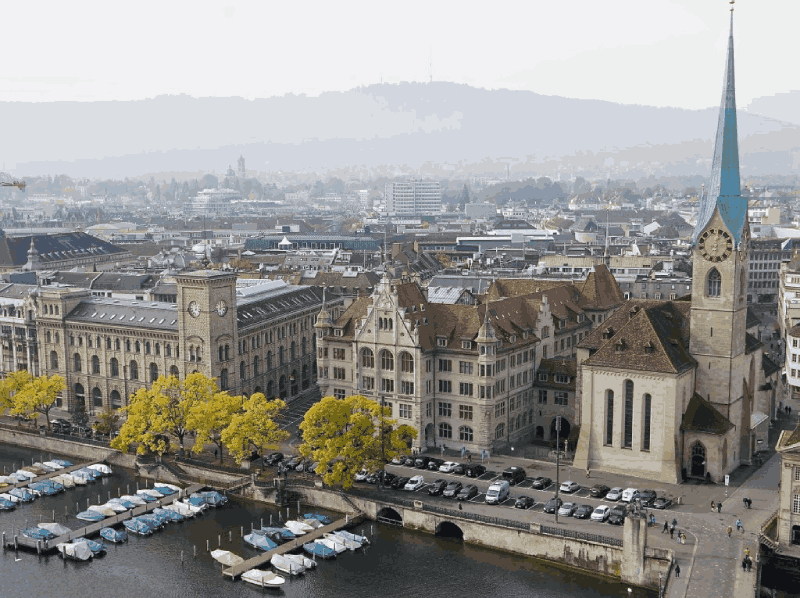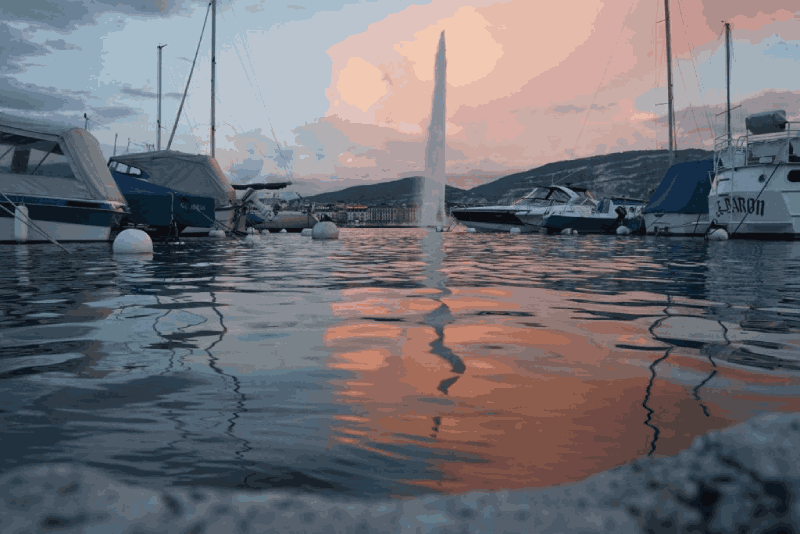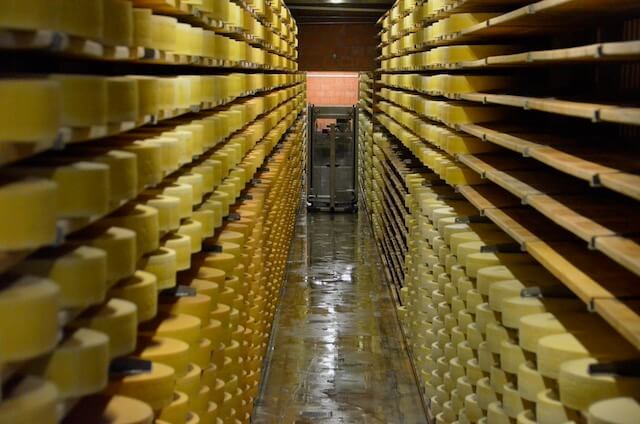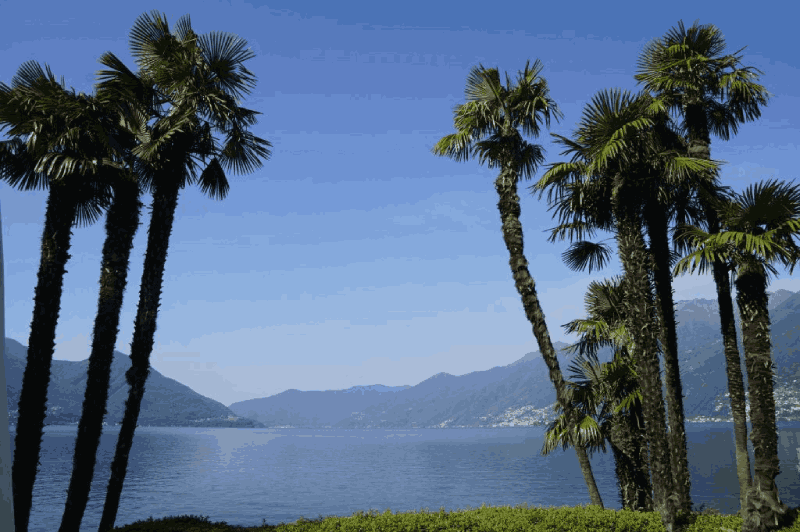Switzerland is that dream country that ends up on most bucket lists: whether its sophisticated cities, adorable villages, or extraordinary hiking trails, this tiny country is a magnet for visitors from every corner of the world.
Perhaps you’ve dreamed of waking up in that cozy wooden chalet, the one with a roaring fire, surrounded by snow-capped mountains and views of crystal-clear lakes?l
Yes, but what is Switzerland known for otherwise? Well, cheese and chocolate, of course.
This tiny country is also known for safety: Swiss travel is so simple, safe, and reliable that a Switzerland solo trip is perfect, even if this is your first visit.

There is no best time to visit Switzerland.
In winter you can ski down steep alpine slopes or climb world-famous peaks. In summer you can hike, take part in cultural events or visit some of the 13 Swiss UNESCO World Heritage Sites.
So what IS Switzerland known for?
Switzerland is a mountainous, landlocked country with more than eight million people, almost a quarter of whom are foreign and 70% of whom live in the lowlands around Zurich, Geneva, and Basel.
The country’s service sector is known for banking, insurance, and tourism, much of it in the alpine regions. But it also has a solid industrial sector as the world’s leading exporter of high-end luxury watches and the home of major pharmaceutical companies − not to mention the invention of velcro, cellophane, and milk chocolate.
Switzerland has also given the world the Red Cross, the Swiss army knife, and Roger Federer, along with the second-largest United Nations headquarters.
And then there’s Swiss fondue, the Rolex watch, Swiss cheese, punctuality – and neutrality.
So yes, Switzerland is known for a lot – not bad for a country one-tenth the size of California.
The main language in Switzerland is often a source of confusion for visitors: there are four different national languages – Swiss German (the most widely spoken), French, Italian, and Romantsch, a mixture of classical Latin, Italian and German dialects.
That said, English is spoken in most Switzerland tourist spots and menus are often in English as well.


A word on women’s rights and cultural issues
You might be surprised to hear women were only given the federal vote in 1971 and that women’s rights still have some way to go in Switzerland. The pay gap is still significant and discrimination in employment is all too common, but there have been major advances: 43% of Swiss parliamentarians are women, a figure that keeps rising.
You may have heard that the Swiss pride themselves on being punctual. It is considered rude to be late and everything from the trains to the buses run like clockwork.
Blame it on the watch industry!
Best of Switzerland
Too often visitors skip right through to the main Switzerland attractions and avoid the cities. These may be a little less charming than the more popular sights, but if you have time, at least try to spend a day in Zurich or Geneva, Switzerland’s two main urban centers.
These are some of the best cities to visit in Switzerland.
Zurich City
The largest Swiss city is certainly worth a visit and in Zurich, safety is not an issue.
One of the great things to do in Zurich alone is to join a free walking tour of Zurich that takes in all the main sites as well as a few less well-known ones.
If you don’t like the tipping approach used by free walking tours and would rather pay for your tours up front, check out these Zurich day tours.
Take some time to visit Grossmünster, literally “the big cathedral”, with its modern stain-glassed windows by Swiss artist Giacometti and climb the 187 steps to the top of Karlsturm where you will get sweeping views of the city.
Or step into the Fraumünster, famous for its stunning 30-foot-tall stained-glass windows by Chagall. Amble through the streets of Niederhof for fun shopping and restaurants. For modern art lovers, hop on a tram or bus, and visit the Zurich Kunsthaus, home to Switzerland’s top collection of modern art including works by Picasso and Monet.
One of the best ways to enjoy Zurich – and perhaps the best way to travel in Switzerland – is to simply walk along the lake and take in the views. The entire country is plastered with walking directions (small yellow signs) that you can follow from any train or bus station and that take you through the most beautiful places to see in Switzerland. It’s a walker’s paradise, and you don’t have to be a hiker or even particularly in shape to enjoy seeing Switzerland on foot.
Need more tips about spending time in Switzerland’s largest city? Here’s a great overview of what you can do in 48 hours in Zurich.
Click here to book your Zurich hotel

Geneva, the Humanitarian City
As Switzerland’s second largest but hugely cosmopolitan city, Geneva has a completely different vibe from the rest of Switzerland.
The weather, dour and despicable in winter, turns bright and radiant in summer, with pretty sailboats bobbing in the water like flocks of excited doves.
Despite its periodic fits and starts, this most cosmopolitan of cities usually spreads out its welcome mat to visitors.
With nearly 30 international organizations and countless non-governmental groups, it has a distinctly international feel and is known as the “Humanitarian City”.
The League of Nations was headquartered here, and Geneva is home to the largest UN office outside New York; the Geneva Conventions were signed here; the Red Cross was born here; and if you want to study humanitarian and international affairs, all the best academic institutions are here. There’s a reason we also call it the ‘Capital of Peace.’
Start your visit with a walk through the Old Town and climb to the top of St Peter’s cathedral (also known as cathédrale Saint-Pierre) for the best views over the city. Loop through the Parc des Bastions below the old town to take in the imposing Reformation Wall and its majestic figures of the reformation leaders.
Even the most mundane sights in this city are original. The city’s most visible − and one of the most famous Switzerland landmarks − is a giant water spout, the 140m/450ft-high jet d’eau, which has graced postcards since 1886.
And then there’s the Geneva flower clock in the Jardin Anglais park. I’m sure wheelbarrows of words have been written about this most Swiss of sights, a clock made of flowers, which are changed every season, and which keeps perfect time – a ticking garden.
If there’s a single photo opportunity in Geneva, this must be it.


If you have time, take a one-hour guided visit of the United Nations headquarters (Sadly, parts of the palace are closed for visitors due to renovations as of 2022. All of the new and upgraded UN buildings are expected to open in 2025). Then cross the road and visit the International Red Cross and Red Crescent Museum and its interactive exhibit (it also has a great and, for Geneva, inexpensive cafeteria).
For insight into Switzerland’s watch-making history and to see some truly exquisite timepieces, visit the beautiful Patek Philippe Museum. Hop the tram into Carouge, Geneva’s trendy little sister.
If you’re looking for things to do alone in Geneva, why not enjoy the Bains des Pâquis, the public swimming baths right on the lake? Have a massage or enjoy the hammam, exclusively for women on Tuesdays.
Or take a chocolate walking tour – you can always go to the spa or the gym and work it off later!
More unusual and difficult to snag is a place on a guided tour of CERN, home of the Large Hadron Collider, the world’s largest particle accelerator.
Is Geneva safe for tourists?
Very much so, but it does have an edge.
Scratch the smooth sparkle and you’ll uncover a second Geneva, one that will appeal to your rebellious streak, whose underside can slap you in the face and which will ensnare you with its character.
Take the walls, whose graffiti competes with fashionable storefronts. Stroll around the red-light district of the Paquis, where partially-unclothed women freeze on winter streets. Enjoy the security of one of the most policed cities on earth, but don’t hang around the train station’s parking lot after dark.
Other than a few slightly racy neighborhoods, though, there’s very little to worry about. Just beware that there is a needle exchange group behind the train station so you may see a few people hanging around waiting for its doors to open. Mostly, everyone minds his or her own business, and Geneva solo travel is pleasant and relaxing. Like any city, though, pack your common sense when you walk around!
While Geneva may be easy to live in or visit, it is also easy to leave: it lies at the center of Europe, and it is home to EasyJet’s second hub after London’s Luton. At rush hour on Friday nights, hordes of corporate and international civil servants rush off for their weekends in Paris or Madrid as quickly as they can drive across town, often with tickets for $50 or less.
(And if you happen to have the time, while in Geneva, take a fabulous day trip to Annecy, right over the border – rated one of the prettiest towns in France).
Click here to book your Geneva hotel
Around Lake Geneva
When you’ve seen enough of the city, here are some of the best places to visit in Lake Geneva, Switzerland.
Its shores are lined with castles, pretty towns and the terraced Lavaux vineyards, recently protected by UNESCO. Any visit to this area should include the imposing medieval Château de Chillon, walking along the beautiful promenade in Montreux and exploring the cobblestoned (and hilly) streets of Lausanne. If you don’t have the time to organize this yourself, this tour will take you to the key sights along the lake.

If you have time, further afield but not on the lake is the storybook, picturesque town of Gruyères where you can learn all about cheese making and indulge in a traditional cheese fondue (as well as visit a museum closely linked to Alien, the movie…)
Click here to book your Gruyères hotel
The Hidden Face of Gruyères: A (Not So) Traditional Swiss Village
If you have time, further afield is the storybook, picturesque town of Gruyères, which has plenty of Swissness crammed into its one tiny street: cheese, chocolate, cobblestones, and a castle.
It’s a perfect day trip from Geneva or Lausanne. If you have no car, take the train to Bulle and the local bus to Gruyères, only a few minutes away.
Foodies will want to taste the moitié-moitié fondue so characteristic of this region, half Gruyère cheese, and half Vacherin, with a hint of kirsch and garlic.

Much of this cheese – 15,000 wheels of it, in fact – is prepared at the Maison du Gruyère, a local cheese factory. This may sound like a lot of cheese but consider this: each Swiss person consumes 21kg or 46lb of cheese a year.
The Chateau de Gruyères stands proudly atop the village, but what is jolting is the juxtaposition of modern art with a 1000-year-old setting, forcing cracks to appear along the region’s otherwise utter Swiss traditionalism.
Where I expected tapestries, I also found bright science fiction, and where I expected a sculpted knight in shining armor, I found a silver harp.
The ancient-modern contrast is nothing compared to the shock you’ll experience across the street at the Giger Museum. The transition from bright sunshine to the museum’s cavelike collection of rooms is jarring, with each exhibit more bizarre than the last. For lovers of the surreal and macabre only. And since you cannot take photographs in the museum, cross the street to the cafe with the same name, which looks eerily like the museum’s interior.



Not far from Gruyères is the ski resort of Charmey – but you don’t have to ski.
Strap on your snowshoes and head for the wild, pristine hills behind Charmey, where the silence is so intense it pierces the ears and wraps itself around you, each crunchy step echoing in the distance.
I was almost hypnotized by the lack of noise, and the snow even began to look… welcoming. I stopped and listened, and heard nothing other than my breath. I saw nothing but white, trees, snow. If I were designing a postcard, I could do no better.

Charmey reconciled me with snow. The quiet beauty of its silent valleys spoke to me. It was a gentle cold, and the snow was soft and powdery.
After snowshoeing, I found refuge in a nearby chocolate factory.
The Cailler plant tour is a chocoholic’s loveliest dream: row upon row of tiny perfect rectangles of Cailler’s signature milk, dark, and white chocolates.
So yes – what with chocolate and cheese and cobblestones and castles (and snow, of course) Gruyères is utterly Swiss. (by Leyla Giray Alyanak)

Lucerne and Central Switzerland
Sitting on the edge of a lake with majestic alpine peaks in the distance, Lucerne was the European aristocracy’s holiday playground in the 19th century. With its picturesque wooden Chapel Bridge, its baroque Jesuit church, and its pretty painted houses, it is still one of “the” amazing places in Switzerland. It’s fabulous at night, and even more spectacular seen from the water (this one-hour cruise will sail you to the perfect vantage point).
Switzerland was actually founded high up in the meadows above Lake Lucerne in 1291, and Lucerne itself is a perfect base for exploring the country’s heartland. Mountain lifts will carry you up to popular destinations like Mount Rigi and Mount Pilatus, and paddle steamers will ferry you across Lake Lucerne.
Click here to book your Lucerne hotel

Zermatt Matterhorn
Ever since the first ascent of the Matterhorn in 1865 and the opening of the Gornergrat cogwheel train in 1898, Zermatt has been one of the top destinations in the Swiss Alps and is one of the most famous places in Switzerland.
Known for its fabulous mountain scenery, the pedestrian-only village is an outdoor paradise, with over 400 kilometers (250 mi) of marked trails for summer hiking and 360km of ski slopes in winter.
For a magical experience, ride the cogwheel train to Gornergrat and book a night at the 3100 Kulmhotel Gornergrat, the highest hotel in Europe – with the best views over the Matterhorn, at sunrise and at sunset (or stay at any of these excellent Zermatt hotels).

Visiting Interlaken
Interlaken is one of the top 10 places to visit in Switzerland, with mesmerizing views of the emerald lakes of Thun and Brienz and the majestic Jungfrau towering above. From paragliding to canyoning, this is the place for adventurous women. Use Interlaken as a base for day excursions to the Jungfraujoch and the Aletsch glacier, the pretty alpine village of Mürren and the Schilthorn above, and the waterfalls of Lauterbrunnen.
A favorite outing is to walk along the shores of Lake Brienz. Take the bus or boat to the picturesque village of Iseltwald and follow the lovely lakeside footpath through the woods, with amazing views of the turquoise waters of Lake Brienz all the way to Giessbach and its 400-meter high waterfall.
Click here to book your Interlaken hotel


Ticino guide
Ticino is the Italian-speaking corner of Switzerland and enjoys a Mediterranean microclimate – and all the charm of Italy with the benefits of Swiss efficiency and order.
From Ascona, Switzerland’s answer to Positano, to Lugano and its colorful piazzas, the Ticino is one of the best destinations in Switzerland, although not necessarily one of the most frequented.
If you pass it by you’ll miss the castles of Bellinzona, the beautiful Verzasca Valley with its famous stone bridge, and ancient villages or boat trips on Lake Lugano.
Click here to book your Lugano hotel




How to travel in Switzerland
Road trips in Switzerland
Switzerland is a wonderful country to see by car (you’ll find some deep car rental discounts here).
Switzerland’s roads are very safe but you’ll need to cope with a range of environments, from three-lane highways to tiny mountain roads with a lot of hairpin bends.
Here are some great Switzerland road trip ideas and planning tips.
Trains and public transport in Switzerland
Switzerland has an excellent public transport network and traveling around the country is super easy. Trains run like Swiss clocks: they are punctual and efficient.
Consider getting a Eurail Pass that includes Switzerland (or a Swiss Pass if you’re only visiting this country). Both give you unlimited access to the trains, buses, and boats. They include free travel on premium panorama trains (advance reservation required); free public transport in urban areas; a 50% discount on mountain excursions; and free admission to 500 museums. Only non-Swiss residents are eligible for the pass. Given the high prices in Switzerland, this is one case in which a train pass will save you a significant amount of money.
There are several Switzerland international airports, which are located in Zurich, Geneva and Basel. Bern, Lugano and Sion have small regional airports operating a limited number of flights.
The best travel in Switzerland is its ‘integrated transport system’. In other words, things actually connect. You can fly into a main airport, connect with a train or bus downtown, take a regional train into the countryside, and connect with a postal bus into the mountains.
Switzerland’s PostBus system is a great way to see the country if you have the time: pretty much every village in the country is served by one of the 2,200 buses on nearly 900 routes.
Where to stay when you travel to Switzerland
Traveling in Switzerland is expensive and hotel accommodation is pricey.
You can choose from the best hotels in Switzerland. Splash out in Geneva’s President Wilson hotel on the lake – for a mere $80,000, you can get a 12-room suite, the most expensive in the world. Or stay in one of these cool hotels in Lucerne.
Or you can sample the other end of the scale, with modern and well-equipped youth hostels or groups like Airbnb.
To book a hotel in Switzerland, browse Booking.com or click on the map below.
Safety issues for women on a solo trip to Switzerland
Given the good record of Switzerland safety coupled with the low Switzerland crime rate, solo female travel is simple and worry-free. You really don’t need to take any specific precautions beyond using your general common sense.
Still, you should take the usual precautions, especially in the bigger cities. It’s not unknown that women to have their drinks spiked in popular urban night spots. Like everywhere sexual assaults do happen and sexual crimes are on the rise.
Pickpocketing is common in cities, especially in crowded areas like markets and stations, so keep your cash and cards safe.
Switzerland is a hiker’s paradise. Throughout the country, you’ll see small canary yellow arrows pointing you toward various hiking destinations and telling you how long it will take you to get there. Just follow them along and explore.
If you’re traveling to Switzerland alone and plan to hike solo, just follow all the usual guidelines: stick to marked trails, always inform someone of your chosen route and use proper equipment. Safety in Switzerland may not be a major issue but the weather in the mountains can change very quickly so pack an extra layer, a water-resistant jacket, and plenty of snacks and water.
And don’t forget to carry around an empty bottle. Everywhere you go, public fountains gush out crystal clear, cold, spring water that is perfectly safe to drink. Many of these fountains are quite beautiful, like in the city of Bern. So remember to always keep an empty bottle with you!
And please – don’t forget your travel insurance before you go! Two outstanding insurers are for travelers are Visitors’ Coverage and SafetyWing – whoever you choose, make sure you get insurance for any trip abroad.
Switzerland FAQS
Is Switzerland expensive to visit?
Yes, there’s no way around that. But you CAN visit without blowing your entire budget. Stay in a hostel rather than in expensive hotels, and eat in cafeterias, shop at the supermarket or focus on lunch rather than dinner.
Do I need a visa to travel to Switzerland?
If you’re a citizen of the US, Canada, Western Europe and a handful of other countries, you don’t need a visa for Switzerland travel. If you’re in doubt, check here.
What is Switzerland known for?
Gruyère cheese. Swiss army knives. Swiss chocolate. Ski resorts. Swiss watches. Heidi. Alps. Swiss trains. Punctuality. The Pontifical Swiss Guard at the Vatican.
Is Switzerland safe generally?
No country is 100% safe but Switzerland safety is usually ranked among the world’s top 10 safest.
Is Switzerland safe for solo female travelers?
It is as safe as it is for anyone. The only proviso is to keep away from dark city streets or country roads at night.
Is English common in Switzerland?
In tourist areas, yes. In the rest of Switzerland, less so.
What are the most famous places in Switzerland?
Mont-Blanc. Zermatt. Matterhorn. Montreux.
Who are the most famous Swiss people?
Albert Einstein. Carl Jung. Le Corbusier. William Tell. Heidi (well, her author, Johanna Louise Spyri). Ursula Andress. Henri Dunant (founder of the Red Cross). Roger Federer.
Switzerland travel resources
- My Switzerland – Switzerland’s official travel website
- Swiss Youth Hostels
- Geneva Pass – for more than 40 attractions
Books to enhance your trip
Pictures for pinning







